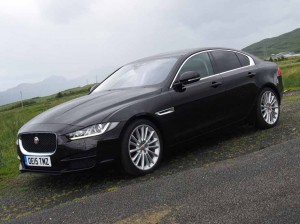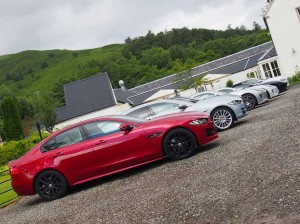… Jaguar XE Portfolio …
 Jaguar has high hopes for its compact executive saloon, the XE, and rightly so. It looks good and goes well. For too long the German triumvirate have ruled this sector of the business car market with BMW’s 3 series, Audi’s A4 and the Mercedes-Benz C Class. Despite attempts by the likes of Ford, Vauxhall, Citroen, Peugeot and Alfa Romeo to grab a share of this lucrative business, the German ‘automobilherstellers’ continue to be the aspirational brands of the upwardly mobile. The reason for that is quite simple, they build bluidy guid motor cars.
Jaguar has high hopes for its compact executive saloon, the XE, and rightly so. It looks good and goes well. For too long the German triumvirate have ruled this sector of the business car market with BMW’s 3 series, Audi’s A4 and the Mercedes-Benz C Class. Despite attempts by the likes of Ford, Vauxhall, Citroen, Peugeot and Alfa Romeo to grab a share of this lucrative business, the German ‘automobilherstellers’ continue to be the aspirational brands of the upwardly mobile. The reason for that is quite simple, they build bluidy guid motor cars.
Enter Jaguar into the fray. Having driven the 178bhp diesel (and the 237bhp petrol) I reckon the Germans have got a serious fight on their hands. Mind you, any car designed by a Scottish led team has a head start, but then I might be ever so slightly biased.
A good looking car is always subjective. What one person thinks is good looking another will find ugly, but for my bawbees it’s the pick of the bunch. The trouble is, from the front it looks like the XF, and there’s a strong family resemblance to all the other Jags with that new grille, although you have to admit, the ‘hooded’ headlamps add a slight touch of menace.
Inside the car, it’s cosy rather than spacious but certainly not cramped. That’s down to the high centre console and the wrap-around dash which sweeps into the doors. There was just one wee niggle though. Taller drivers might prefer the non-sun-roof version as the housing around the aperture kept trying to knock my bunnet off. That meant I had to recline the seat just a tad more than I would have liked. However, the seats are excellent offering good support and plenty of adjustment – for those not wearing bunnets! And maybe it’s just a good job the bee-hive is out of fashion these days, or the wife wouldn’t like it either.
The dashboard itself is pretty dark until you stab the starter button and the 8 inch central display lights up alongside the digital dials which mimic the old-school speedo and rev counter. There’s plenty of buttons on the steering wheel and fewer on the console which means that the touchscreen interface has to be used to access minor functions, of which there are dozens, maybe even hundreds for all I know.
Thanks goodness there was a boffin on hand. For instance I complained that the figures and symbols on the laser head-up display were too bright. It wasn’t so much that they were distracting, but they were annoying. However, there was a control buried deep in the menu to dim them separately from the main binnacle illumination. Nice touch, but a devil to find without resorting to the Handbook – or the boffin.
And I know it’s silly, but when you do stab the start button, the delightfully tactile gear selector knob rises out of the console from its flush fit. I still like that.
 There was however an extra button beside the control centre which operated the ‘All Surface Progress Control’ system. This is just a fancy name for what you and I would call an electronic limited slip diff. Sadly that doesn’t appeal to the majority of folks who will buy this car hence the fancy moniker. Borrowed from their colleagues at Land Rover what the ASPC does is help folk unused to (or lacking confidence in) rear wheel drive to keep on the move when winter closes in. Ideal for slippery or hill-starts, the system will transmit the correct amount of power to the rear wheels depending on conditions. It functions up to 30 kph before switching itself off.
There was however an extra button beside the control centre which operated the ‘All Surface Progress Control’ system. This is just a fancy name for what you and I would call an electronic limited slip diff. Sadly that doesn’t appeal to the majority of folks who will buy this car hence the fancy moniker. Borrowed from their colleagues at Land Rover what the ASPC does is help folk unused to (or lacking confidence in) rear wheel drive to keep on the move when winter closes in. Ideal for slippery or hill-starts, the system will transmit the correct amount of power to the rear wheels depending on conditions. It functions up to 30 kph before switching itself off.
Controlling that power is an 8 speed automatic (or six speed manual) gearbox which naturally has a ‘Sports’ setting and steering wheel paddles while the power in this case was generated by the brand new Ingenium 2 litre diesel. It’s worth noting at this point that the 161bhp version of this engine produces just 99g/km, but this was the 178bhp version which still produced only 109g/km.
On start up, there’s no disguising the fact that the engine is a diesel, but it soon settles down, although it is still that little bit louder than the BMW offering. However, it didn’t intrude and on a personal note it actually sounds better than the petrol option!
On the move all that is forgotten, the car rides superbly well, steers like a dream and the suspension soaks up the worst of Argyll’s rain guttered and landslide prone roads. There was a bit of road noise from the 19 inch tyres so if it’s ultimate comfort you’re after, the standard 17 inch jobs might just be preferable.
The trouble is the car drives so well, the grip is so good and the ride so quiet that speed limits are easily breached. Thank goodness for the Head-Up display and the forward pointing camera, which notes the speed signs and relays them to the display alongside the digital read-out!
This is a quick car, not a fast car (like the F Type R!), but the mid range torque from the new engine gets you out and past the tourists and caravans briskly and back in again safely, not to mention the log haulers that populate the west coast roads at this time of year.
 It’s not too big either considering the encounter with a Garelochhead Coaches holiday cruiser on the narrow, twisting coastal road south of Arrochar! That’s not to say the coach driver was doing anything wrong, we just happened to meet up on a particularly narrow stretch. A cheery wave to each other, job done. How that coach driver can remain so cheery considering the thoughtless, careless idiots he must meet on a daily basis I don’t know, but that’s another story. Maybe he was just looking forward to a traditional Scottish high tea at his next stop, hence the good mood.
It’s not too big either considering the encounter with a Garelochhead Coaches holiday cruiser on the narrow, twisting coastal road south of Arrochar! That’s not to say the coach driver was doing anything wrong, we just happened to meet up on a particularly narrow stretch. A cheery wave to each other, job done. How that coach driver can remain so cheery considering the thoughtless, careless idiots he must meet on a daily basis I don’t know, but that’s another story. Maybe he was just looking forward to a traditional Scottish high tea at his next stop, hence the good mood.
Anyway, the drive was sufficient to convince me that the German specialists now have a serious rival on their executive patch. If you’re in the market for a company car, the choice just got harder – or maybe easier!
There is an entry level car at just under 30 grand, but this was the ‘Portfolio’ model at £35,425.00 and which had another ten grandsworth of options. For instance the ‘Black Cherry Premium’ paint job was an extra £1200, 19 inch wheels £800, heated steering wheel £185, illuminated Sill Tread Plates £408, powered boot lid £430, Head-Up display £1435, parking assistance and camera £1540 and something called a Wi-Fi Hotspot which at 300 quid sounded a trifle expensive. So be careful what you specify.